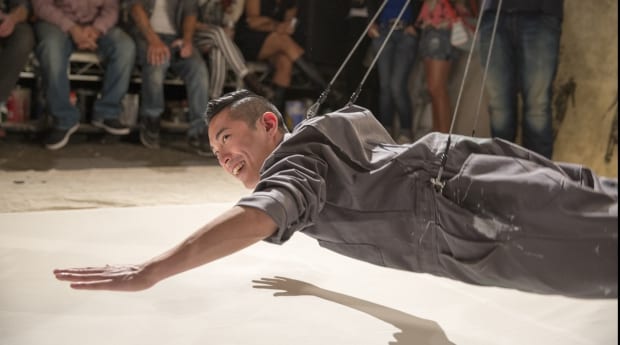When he was invited to compete in a new CBC TV program that pits artists against one another, Jay Cabalu didn’t expect to confront his deep theological ambivalence.
Crash Gallery brings three artists together, gives them a challenge and then the audience votes until only one of the three is left standing. The first challenge in Cabalu’s episode was a sort of inversion of Michelangelo’s Sistine Chapel ceiling — the artists were instructed to paint their interpretation of heaven on a canvas on the floor while suspended mid-air.
Coming from a Filipino family, Cabalu attended Catholic high school but in recent years moved away from the church and also came out as gay.
“So all of that I’ve been dealing with in the last couple of years and then I show up at Crash Gallery and our first challenge is to paint heaven,” he says, laughing. “Naturally, my first reaction was, ‘Really?’”
Cabalu, who has a bachelor of fine arts from Kwantlen Polytechnic University and whose preferred medium is collage, decided to take up the challenge on his own terms.
“There was no way that I was going to do it literally because I’m not sure that I believe in heaven in a very literal sense,” he says. “Nobody knows what heaven actually is, or if it is, so why am I going to paint my perspective of what heaven is when it’s no more valid than what you feel heaven is?”
“That’s how I figured out how to do the challenge and yet not necessarily do the challenge,” he says, still laughing.
In the end, he left the centre of the large canvas white and surrounded it with chaotic masses of colour and texture.
“I wanted to make the focal point, the middle part of the painting, essentially just white so that there would be a blank space for the viewer to project their feelings about heaven,” he says. “I just painted colour all around the edges of the canvas and I used all kinds of textures around in the coloured areas to represent the physical world and maybe the chaos that we bring to each other in the name of heaven.”
When the audience voted, Cabalu was eliminated, but he regrets nothing.
“That’s just how an audience vote is,” he says. “Win or lose, I did what the show set out to do. I wouldn’t have done anything differently.”
He’s now back at his part-time job at a commercial gallery in South Granville and devoting most of his free time to collage works. He emphasizes pop culture, using “anything that’s paper that I can glue down to a surface,” including maps, comic books and fashion magazines.
Pop culture became a refuge when Cabalu was younger. Because he went to Catholic school in Port Coquitlam but lived in Burnaby, he rarely saw his friends outside of class.
“I would often feel isolated and I think a lot of gay kids feel that way, regardless of what your upbringing is,” he says. “A way that I felt that I was able to engage and feel like I belonged to a culture was through pop culture. It’s one of those things that pop culture does for people. It provides a sense of belonging because it’s such a global culture. You can take part in it and feel like you belong to something, even if it’s superficial.”
But he is also a critical thinker and participates in pop culture even while deconstructing it. “From an early age, I wasn’t just entertained by it, I was also interested in the politics behind pop culture,” he says.
Cabalu believes being gay has infused his artwork with insight. “I don’t remember a time when I didn’t know that I wasn’t different in some way,” he says. “When you grow up with that frame of mind, you just learn to see the world in a different way and to look at the other side of the coin.”
To see Jay Cabalu’s collage artwork go to jaycabalu.com.

 Why you can trust Xtra
Why you can trust Xtra


